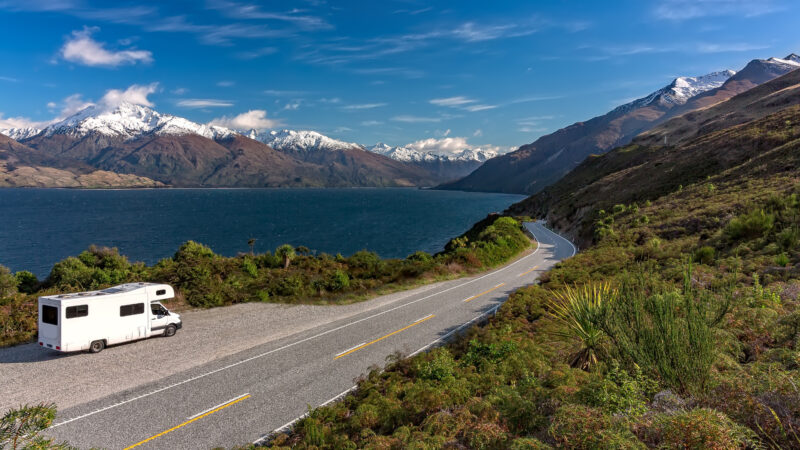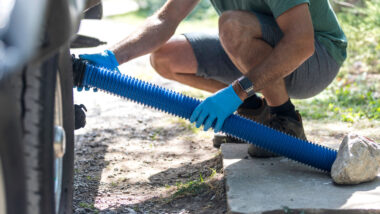Table of Contents Show
There’s never been a more popular time to own an RV than now. Over the last few years, it seems like everybody and their dog have become RV owners.
RV dealership lots sat empty for a while, and campground reservations are still nearly impossible to acquire at some spots. So who do we have to thank for all of this craziness? Who invented the RV?
Today, we’re taking you through a short history lesson to discover where #RVlife started. Buckle up, and let’s get started!
What Is an RV?
An RV, or recreational vehicle, is a motor vehicle or trailer designed for travel and recreation. It typically contains living quarters with a bed, kitchen, and bathroom. People use them for camping, road trips, or as permanent residences.
They come in various sizes and styles, ranging from small trailers you can tow behind a car to large, luxury motorhomes that accommodate larger families.
They’ve become a popular way for people to travel and explore the country. Travelers love that they offer a comfortable and convenient way to experience the great outdoors while still enjoying the amenities of home.
When Were RVs Invented?
The origins of RVing go back as far as the early 20th century. Travel trailers and motorhomes first started appearing in the 1910s. However, the first commercial RVs hit the market in the 1920s, and the 1930s saw a massive boom in RVing.
These campers were simple trailers pulled behind cars or trucks. They certainly didn’t have the amenities and features many of us enjoy in our rigs today.
It wasn’t until the 1950s that fully-contained vehicles hit the market as motorhomes. Ray Frank created the “Motorhome Coach,” which utilized a Dodge truck chassis and included a sleeping area, bathroom, and small kitchen.
Over the years, RVs have continued to evolve and improve. Manufacturers started incorporating more amenities and features to create more comfortable and convenient campers.
Today, you can find RVs with high-speed internet, multiple bathrooms, and auto-leveling systems. They’ve come a long way since the early days.
Who Is Roland R. Conklin?
Roland R. Conklin was an American inventor and entrepreneur in the early 1900s. Due to the family’s success in several business ventures, they were considered one of the wealthiest families in the country.
Roland Conklin launched the American Motor Coach Company in 1901, specializing in making custom luxury buses.
Then the entrepreneur saw the possibility of combining the luxury experience of hotels with tent camping. He then created a vehicle with beds, seating areas, storage space, and a kitchen.
However, he didn’t do it alone. He leaned on his wife to ensure the idea appealed to multiple demographics. He gave his creation the name “Gypsy Van.”
Conklin continued to innovate and improve his original motorhome design. He founded several other successful companies in the RV and transportation industries. He pioneered the modern RV industry, and his contributions have helped shape how people travel and live on the road today.
About the Conklin Family’s RV Trip
What better way to showcase Conklin’s creation than to hit the road with his family? So that’s what they did. The family loaded the 25-foot, 8-ton beast in Huntington, N.Y., and hit the road for San Francisco, Calif.
The family spent two months crossing the United States in the Gypsy Van. It attracted national attention, and thousands watched as they trekked westward.
However, this was long before the internet and social media platforms. Individuals had to wait for the New York Times and other popular media outlets to update readers of their newspapers.
The Conklins set the stage for modern RVing. They provided everyone with a glimpse of the possibilities. Whether you travel full-time in your RV or enjoy it recreationally for shorter trips, you have the Conklins to thank for helping to bring attention to the lifestyle.
The Earliest RVs
While many opposed the adoption of RVs for camping, they were selling like hotcakes during the 1930s. Some estimates say more than 400 travel trailer companies launched during the 30s.
Many of the biggest names in the industry today started during this time. Let’s look at some of the earliest RVs and how they helped shape the future of RVing for modern consumers.
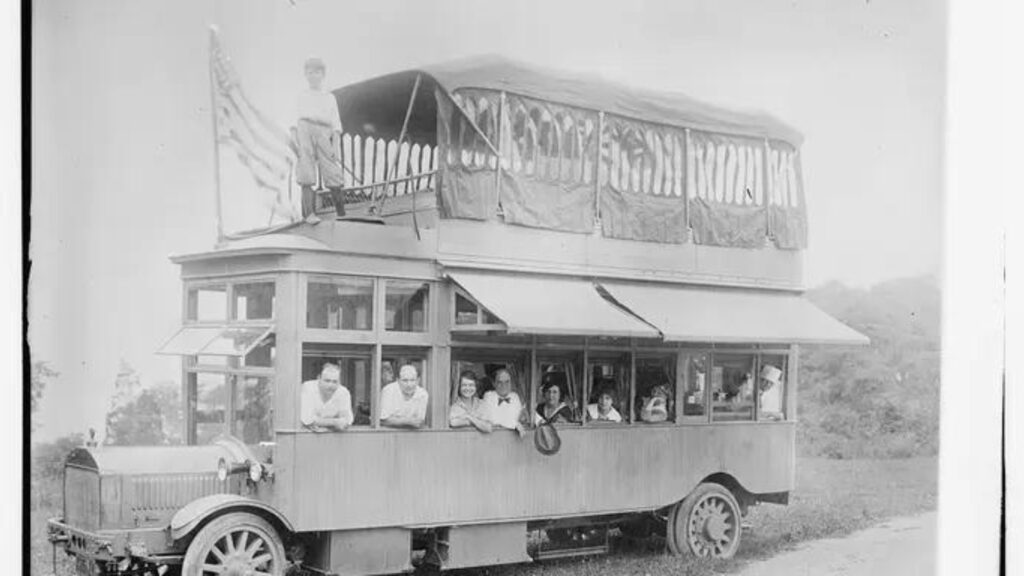
The Covered Wagon Company: Founded in 1930
Arthur G. Sherman went out for a camping adventure in a trailer-mounted tent. These were common then and used a folding frame to support the structure. However, setup was very difficult, especially in rainy conditions, as Sherman experienced.
Like most good inventors, he thought there had to be a better way. Thus, Sherman hired a carpenter to construct a basic wooden cabin on wheels.
When complete, he and his family tested it on a camping trip. They had a much more enjoyable experience, and other campers flocked to his campsite to inquire about the structure.
He started The Covered Wagon Company, which mass-produced trailers from 1929 to 1958. As the demand for their units increased, the factory churned out 1,000 camping trailers per month. These were the first trailers to provide electric brakes, waterproof exteriors, and sinks with running water.
Like most manufacturers, the company drastically adjusted its manufacturing during World War II. Instead of producing camping trailers, they began cranking out cargo bodies for trucks to support the war effort.
Unfortunately, the company never resumed producing trailers after World War II ended.
Airstream: Founded 1931
Airstreams and their all-metal designs are the most iconic trailer in the RV industry. You can instantly recognize an Airstream from the second it pulls into the campground. These luxury trailers have a premium price tag.
However, their unique constructions have helped them to last for decades. Airstream states, “Approximately 70 percent of the Airstream travel trailers ever built are still on the road.”
Wally Byam, the company’s founder, spent the 1920s building trailers in his backyard in Los Angeles, Calif. He used surplus airplane aluminum, which was very different from what others used at the time.
He had a passion for traveling and being an entrepreneur. Launching a company around recreational vehicles made the perfect combination.
After several years of producing trailers in his backyard, Byam introduced the Airstream Clipper in 1931. Campers loved the aerodynamic shape, clean aluminum exterior, and quality construction.
The company quickly grew its reputation in the RVing community and became a symbol of travel in American pop culture.
Today, Airstream is one of the leading brands in the massive RV industry. Despite the huge price tags, it’s not uncommon for the manufacturer to have a lengthy waitlist for production. However, many customers find they’re worth the price and the wait.
Keep in Mind: Airstreams are a classic, but they’re pricey! So why are Airstreams so expensive?
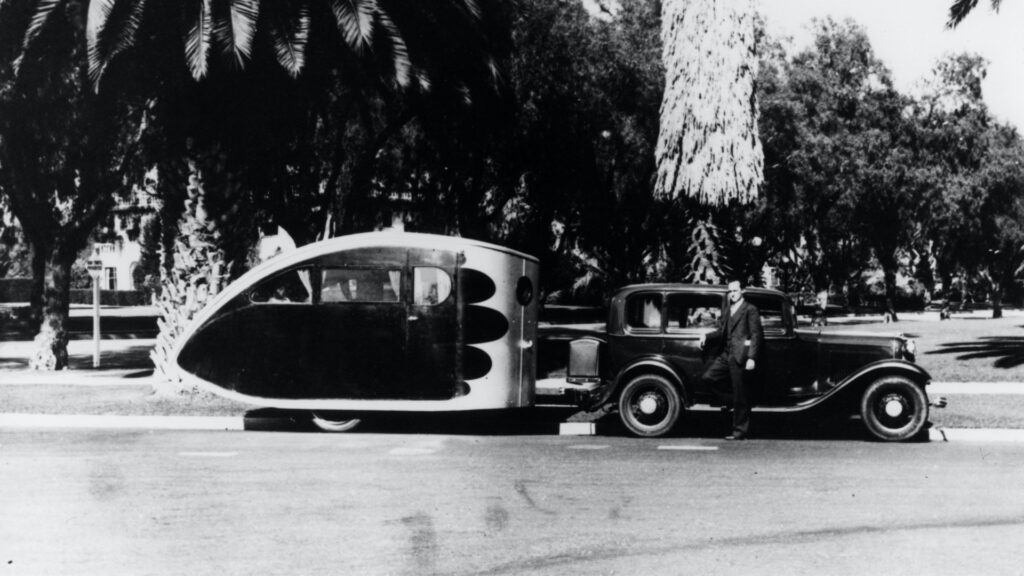
The Jungle Yacht: Used in 1938
Much like RVing, #vanlife has become incredibly trendy in recent years. However, people have traveled the country in vehicles since automobiles first hit the roads. They may not have had auto-leveling, satellite TV, and other luxuries, but they did the job.
The Jungle Yacht exemplifies the possibilities during the late 1930s and early 1940s. Unfortunately, only two Jungle Yachts were created, and no one knows where they are today.
These massive vehicles provided a hotel-like luxury experience for passengers during their adventures. The Jungle Yachts were most notably used on two African expeditions.
The Jungle Yacht was the brainchild of Attilio Gatti, an African explorer during the 20th century.
After draining his bank account while exploring the continent of Africa, he came to the United States in 1930. He hoped coming to America would allow him to raise funds to continue his dream of exploring Africa.
He partnered with International Harvester for his tenth and final expedition. They built two Jungle Yachts for him and his team to use during the journey.
The two vehicles sat on a 1937 International Harvester D-35 chassis. They were 44 feet long and weighed 9 tons, which didn’t make them easy to maneuver.
The vehicles featured a bedroom, a full bath, an all-electric kitchen, and an office. And it had plenty of room for Gatti’s research equipment and appliances.
Additionally, the Jungle Yacht had air conditioning, a bathtub, and a 110-Volt generator to power the electric lighting and other appliances.
At the time, these units cost $15,000, which translates to approximately $300,000 today. However, if you can find one of these two vehicles, they’re likely worth much more than that today.
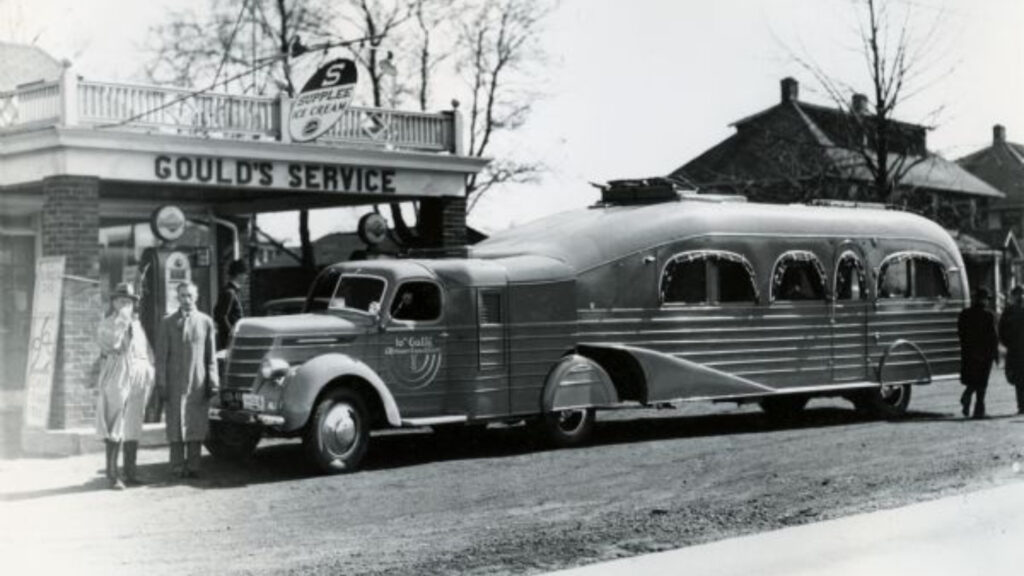
Best Museums for RV History
If you enjoy RVing or are a history buff, don’t miss some of these museums. Here are a few of the best RV history museums you’ll want to consider when making your travel itineraries. Let’s take a look!
RV Hall of Fame and Museum (Indiana)
The RV Hall of Fame and Museum in Elkhart, Indiana, preserves the history and culture of recreational vehicles and the RV industry. The museum features a variety of exhibits that showcase the history of RVs, from early trailers and campers to modern luxury motorhomes.
Visitors can see antique and vintage RVs, including a 1913 Earl Travel Trailer and a 1929 Covered Wagon trailer. In addition, guests can experience modern RVs like a Prevost motorhome and a prototype of a futuristic RV.
The museum also offers a research library, a gift shop, and a theater that screens films about the history of the RV industry.
The museum hosts events and special exhibitions throughout the year. This includes the annual Hall of Fame induction ceremony, which honors individuals who have contributed significantly to the RV industry.
Volo Auto Museum (Illinois)
The Volo Auto Museum in Volo, Illinois, features over 33 exhibits and displays showcasing a variety of automobiles, from vintage and classic cars to modern supercars and movie vehicles.
While their automobile display may get all the attention, they also have some incredibly rare vintage RVs.
The museum houses a 1928 Ford Model A House Car. Converting vehicles into homes on wheels was common during the 1920s as people traveled looking for work during the great depression.
However, this specific vehicle was built by Ford and is one of two known to exist. When it comes to rare campers, this is about as rare as it gets!
In addition to the 1928 Ford, you’ll have a chance to peek inside several other RVs from the 1930s, 40s, and 60s.
To top off the camper exhibit, they have a variety of memorabilia from the glory days of road-tripping. Vintage items like canned goods, games, fishing gear, and antique radios are on display.
Keep in Mind: So what’s actually considered a Recreational Vehicle? Click the link to find out!
John Sisemore Traveland RV Museum (Texas)
The John Sisemore Traveland RV Museum is in Amarillo, Texas. The museum showcases vintage RVs and trailers, including some of the earliest models of RVs from the 1930s and 40s.
The museum’s extensive collection includes over 30 vintage and classic RVs, including a 1935 Bowlus Road Chief, a 1946 Spartan Manor, and a 1960s Airstream Bambi.
Each vehicle in the museum’s collection is restored and displayed to its original condition, providing visitors with a unique look into the history of the RV industry.
In addition to the exhibits, the John Sisemore Traveland RV Museum offers a variety of interactive experiences, including a virtual reality tour that allows visitors to experience what it’s like to travel in an RV.
The museum also has a gift shop where visitors can purchase RV-related souvenirs and merchandise.
RVing Isn’t a New Phenomenon
While RVing may seem trendy now, it’s nothing new. RVing is a pastime that has been around for nearly a century. However, it has evolved from simple camping trailers to today’s luxury motorhomes.
The RV lifestyle has become a popular way for people to explore the country and enjoy the great outdoors.
Whether you’re a seasoned RV enthusiast or just getting started, there’s never been a better time to hit the road and explore all that this great country has to offer.




